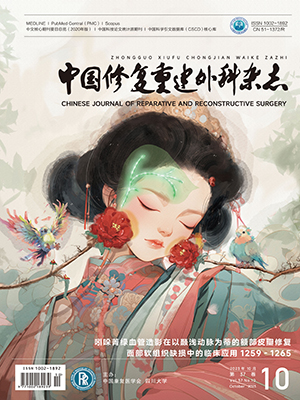| 1. |
Senaratne J, Irwin ME, Senaratne MP. Pacemaker longevity: are we getting what we are promised? Pacing Clin Electrophysiol, 2006, 29(10): 1044-1054.
|
| 2. |
Hauser RG, Hayes DL, Kallinen LM, et al. Clinical experience with pacemaker pulse generators and transvenous leads: an 8-year prospective multicenter study. Heart Rhythm, 2007, 4(2): 154-160.
|
| 3. |
Yu FX, Ke JJ, Fu Y, et al. Protective effects of adenosine in rabbit sinoatrial node ischemia-reperfusion model in vivo: control of arrhythmia by hyperpolarization activated cyclic nucleotide-gated (HCN) 4 channels. Mol Biol Rep, 2011, 38(3): 1723-1731.
|
| 4. |
Meng F, Wang K, Aoyama T, et al. Interleukin-17 signaling in inflammatory, Kupffer cells, and hepatic stellate cells exacerbates liver fibrosis in mice. Gastroenterology, 2012, 143(3): 765-776. e1-3.
|
| 5. |
鄧松柏, 佘強. 竇房結自動除極相關離子通道的研究進展. 心血管病學進展, 2008, 29(5): 736-739.
|
| 6. |
Verkerk AO, van Ginneken AC, Wilders R. Pacemaker activity of the human sinoatrial node: role of the hyperpolarization-activated current, I(f). Int J Cardiol, 2009, 132(3): 318-336.
|
| 7. |
Chandler NJ, Greener ID, Tellez JO, et al. Molecular architecture of the human sinus node: insights into the function of the cardiac pacemaker. Circulation, 2009, 119(12): 1562-1575.
|
| 8. |
Moosmang S, Biel M, Hofmann F, et al. Diferential distribution of four hyperpolarzation activated cation channels in mouse brainl. Biol Chem, 1999, 380(7-8): 975-980.
|
| 9. |
Rosen MR, Robinson RB, Brink PR, et al. The road to biological pacing. Nat Rev Cardiol, 2011, 8(11): 656-666.
|
| 10. |
Roubille F, Tardif JC. New therapeutic targets in cardiology: heart failure and arrhythmia: HCN channels. Circulation, 2013, 127(19): 1986-1996.
|
| 11. |
Später D, Abramczuk MK, Buac K, et al. A HCN4+ cardiomyogenic progenitor derived from the first heart field and human pluripotent stem cells. Nat Cell Biol, 2013, 15(9): 1098-1106.
|
| 12. |
Chandler NJ, Greener ID, Tellez JO, et al. Molecular architecture of the human sinus node insights into the function of the cardiac pacemaker. Circulation, 2009, 119(12): 1562-1575.
|
| 13. |
Choi KH, Park JK, Kim HS, et al. Epigenetic changes of lentiviral transgenes in porcine stem cells derived from embryonic origin. PLoS One, 2013, 8(8): e72184.
|
| 14. |
Tiscornia G, Singer O, Verma IM, et al. Design and cloning of lentiviral vectors expressing small interfering RNAs. Nat Protoc, 2006, 1(1): 234-240.
|
| 15. |
Lim TT, Geisen C, Hesse M, et al. Lentiviral vector mediated thymidine kinase expression in pluripotent stem cells enables removal of tumorigenic cells. PLoS One, 2013, 8(7): e70543.
|
| 16. |
賈建博, 方易冰, 卞鐵榮, 等. 脂質體介導hHCN2基因轉染HEK293細胞的效率研究. 瀘州醫學院學報, 2012, 35(3): 248-250.
|
| 17. |
Nong Y, Zhang C, Wei L, et al. In situ investigation of allografted mouse HCN4 gene transfected rat bone marrow mesenchymal stromal cells with the use of patch-clamp recording of ventricular slices. Cytotherapy, 2013, 15(8): 905-919.
|
| 18. |
El Khoury N, Mathieu S, Marger L, et al. Upregulation of the hyperpolarization activated current increases pacemaker activity of the sinoatrial node and heart rate during pregnancy in mice. Circulation, 2013, 127(20): 2009-2020.
|
| 19. |
Bosman A, Sartiani L, Spinelli V, et al. Molecular and functional evidence of HCN4 and caveolin-3 interaction during cardiomyocyte differentiation from human embryonic stem cells. Stem Cells Dev, 2013, 22(11): 1717-1727.
|
| 20. |
Scavone A, Capilupo D, Mazzocchi N, et al. Embryonic stem cell-derived CD166+ precursors develop into fully functional sinoatrial-like cells. Circ Res, 2013, 113(4): 389-398.
|
| 21. |
Lu W, Yaoming N, Boli R, et al. mHCN4 genetically modified canine mesenchymal stem cells provide biological pacemaking function in complete dogs with atrioventricular block. Pacing Clin Electrophysiol, 2013, 36(9): 1138-1149.
|
| 22. |
Müller M, Stockmann M, Malan D, et al. Ca2+ activated K channels-new tools to induce cardiac commitment from pluripotent stem cells in mice and men. Stem Cell Rev, 2012, 8(3): 720-740.
|




